A hemispherical dome projection process developed by Philippe Jaulmes in France.
Film Explorer
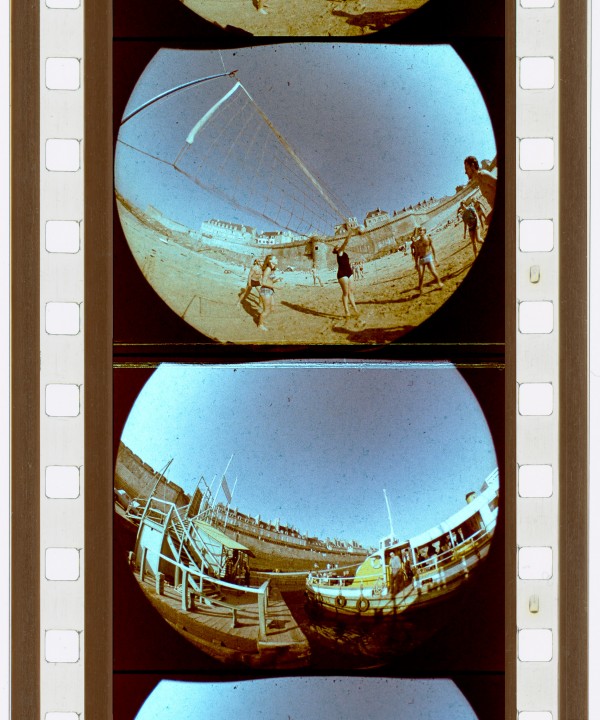
A 35mm print of La Grande Marée (1966) with CinemaScope perforations and four magnetic tracks. Shot in Saint-Malo, France, and screened at Expo 67 in Montreal, Canada, in a hemispherical hall 8m (26.25 ft) in diameter. This version of PANRAMA had a frame four perforations tall and advanced the film through the projector vertically.
Courtesy of Frédéric Jaulmes.

A 35mm horizontal print of Languedoc-Roussillon terre des possibles (1992).
Cinémathèque française, Paris, France.

The Tolbiac viaduct in Paris, no longer in existence. 35mm print of Labyrinthe en Panrama (1981), produced for the opening of the PANRAMA theater in Paris, rue de la Gaîté, in 1981. This film was initially projected horizontally with a 35mm frame eight perforations wide. Subsequently, screening prints were made on 70mm film.
Courtesy of Frédéric Jaulmes.
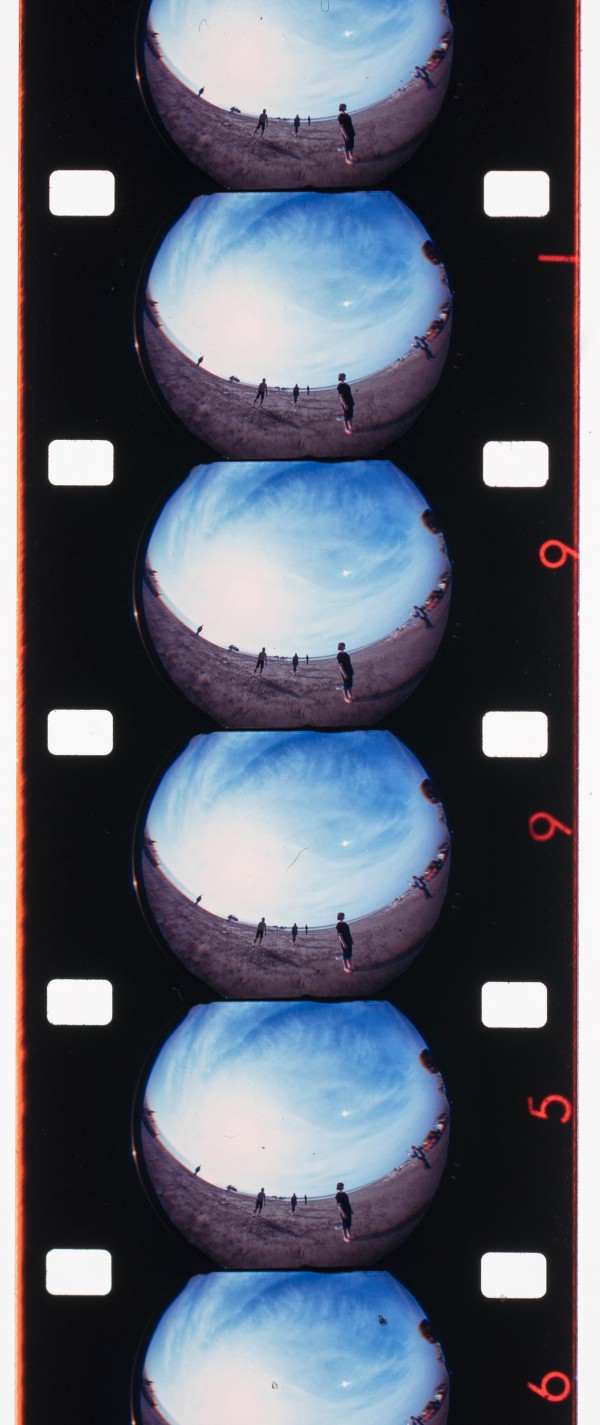
The 16mm PANRAMA format used a circular fisheye image projected onto a domed screen. This was a 1975 test, for a project with the Centre culturel du Marais, Paris
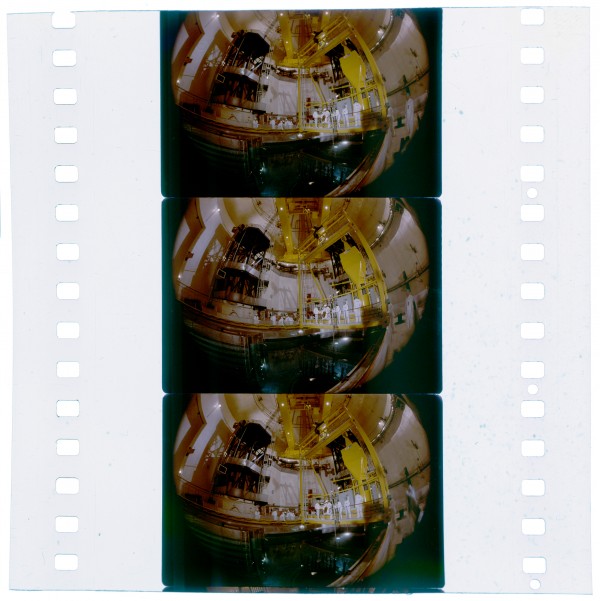
Some PANRAMA films like Bugey (1981), were transferred to 70mm for presentation at the PANRAMA theater at Espace Gaîté, Paris.
Courtesy of Frédéric Jaulmes.
Identification
23mm x 19mm (0.905 in x 0.748 in) (4-perforation, 35mm); 33mm x 23.75mm (1.299 in x 0.935 in) (8-perforation, 35mm); 31mm x 23.5mm (1.220 in x 0.925 in) (70mm).
1.21: (4-perforation, 35mm); 1.32:1 (8-perforation, 35mm); 1.32:1 (70mm)
Kodak Standard (KS) (most releases); CinemaScope (CS) for La Grande Marée (1966) and L’Automobile et l’environnement (1972).
Color or B/W.
Standard Agfa or Eastman Kodak edge markings.
1
Some surviving prints now suffer from color fading.
Procédés PANRAMA de Philippe Jaulmes
For 35mm standard: music illustrations on magnetic tape; horizontal 35mm films: separate sound on 35mm full-coat magnetic film; films La Grande Marée et L’Automobile et l’environnement: four magnetic stripe soundtracks, coated on the print’s edges.
Stereo, also four-track (PANRAMA theater, Clapiers) and six-track (Espace Gaîté, Paris).
Full frame in any format (perforation to perforation, without reserve for optical soundtrack).
Color or B/W.
Eastman Kodak or Fuji.
History
French architect and inventor Philippe Jaulmes developed his PANRAMA system for inclined hemispherical film projection in the late-1950s. Initially intended for use with 16mm film, Jaulmes announced the format in a public presentation at the World Exhibition in Brussels in 1958, but it was not until 1961 that the first dedicated PANRAMA auditorium was installed, in the basement of Jaulmes’s architect's office. It included a screen 4m (13.12 ft) in diameter, which was used for further refinement of the process, including studying variations in the inclination of the domed screen, as well as testing screen coatings and light reflectance. A 1.98mm Kinoptik fisheye lens was used on the camera, patented by Edgar Hugues in 1960. The format was upgraded to 35mm around 1963.
Initially, Jaulmes had developed the concept of projection on a hemispherical screen during his studies in architecture, and this concept had been the subject of his diploma, submitted in June 1955. In his dissertation, and first patent from 1958, the concept for his theater of “Total Projection” was described in some detail. The auditorium should be a circular room, with a spherical dome-shaped ceiling, the entire concave surface of which became the projection screen. The projection intensity should be bright enough for the entire dome space to be evenly lit. The side supporting walls should be limited in height as far as possible. These walls were to be lined with light- and sound-absorbing material, ideally “noirs et perforés” (“black and perforated”). The projection apparatus was to be mounted in the center of the auditorium, at a height of 1.2m (3.94 ft) above the floor. The audience would sit, or recline, to view the image above them. The floor was to have a circular incline of 5 degrees towards the center, to ensure that the field of vision for all members of the audience was clear. Therefore, the projection cone needed to be slightly less than 180 degrees, so that the heads of the audience, in a seated position, would not encroach into the projection frame. For a horizontal floor and a standing audience, Jaulmes recommended a height of 2m (6.56 ft) from the floor for the projection apparatus (Jaulmes, 1963: p. 88).
Jaulmes also proposed the possibility of synchronizing two projectors, and several loudspeakers placed behind the screen: a single loudspeaker at the zenith, four loudspeakers in a middle ring, and eight in a lower ring. The alignment of the speakers should be perpendicular to the screen. Stereo sound should reflect the “synesthésie des sons et des couleurs” (“synesthesia of sounds and colors”) (Jaulmes, 1963: p. 91).
In the early 1960s, Jaulmes finalized the PANRAMA system in its most advanced versions: in both 16mm and 35mm formats with a 30- to 45-degree tilted dome screen, 4m (13.12 ft) in diameter. The projector was mounted near the top of the dome and pointed down towards a concave spherical mirror, which reflected the image up onto the hemispherical screen (Jaulmes, 1963: fig. 18, p. 99).
Following a temporary installation at Expo ‘67 in Montreal, where the film La Grande Marée (1966) was exhibited, the first permanent PANRAMA installation came in 1969 in Clapiers, north of Montpellier, France, with a domed screen 12m (39.37 ft) in diameter and room for 50 people. A second, larger permanent PANRAMA theater, called Espace Gaîté, followed in Paris in 1981, which could seat an audience of 235. Jaulmes made his own dome films and collaborated with various artists, including Gilbert Comparetti. PANRAMA projection converted to digital in 1998, and continues to run to this day.
Selected Filmography
35mm, 8-perforation, horizontal, color. A 10-minute experimental film. An apocalyptic vision of a future world featuring fisheye macro photography of a world overrun by insect survivors. Made for the 18m diameter dome at the Espace Gaîté PANRAMA theater in Paris.
35mm, 8-perforation, horizontal, color. A 10-minute experimental film. An apocalyptic vision of a future world featuring fisheye macro photography of a world overrun by insect survivors. Made for the 18m diameter dome at the Espace Gaîté PANRAMA theater in Paris.
35mm, 4-perforation, vertical, color. A 5-minute documentary shown at the 1972 Paris Motor Show, in the presence of French President Georges Pompidou, in the same sphere used at Expo ‘67 in Montreal.
35mm, 4-perforation, vertical, color. A 5-minute documentary shown at the 1972 Paris Motor Show, in the presence of French President Georges Pompidou, in the same sphere used at Expo ‘67 in Montreal.
35mm, 4-perforation, vertical, B/W. A 28-second animation film. The first computer-generated film for PANRAMA. Specially designed for projection in the Clapiers PANRAMA theatre. A cage and other geometric objects move through space, until they engulf the spectators.
35mm, 4-perforation, vertical, B/W. A 28-second animation film. The first computer-generated film for PANRAMA. Specially designed for projection in the Clapiers PANRAMA theatre. A cage and other geometric objects move through space, until they engulf the spectators.
35mm, 4-perforation, vertical, color. A 15-minute documentary that reused parts of the earlier films Osaka en Panrama (1970) and USA en Panrama (1973). The 35mm footage was converted to 70mm film for screening at the newly opened Espace Gaîté PANRAMA theater, rue de la Gaîté, Paris.
35mm, 4-perforation, vertical, color. A 15-minute documentary that reused parts of the earlier films Osaka en Panrama (1970) and USA en Panrama (1973). The 35mm footage was converted to 70mm film for screening at the newly opened Espace Gaîté PANRAMA theater, rue de la Gaîté, Paris.
35mm, 4-perforation, vertical, color. A 6-minute documentary about Dinard, Saint-Malo and the Rance tidal power plant in Brittany. PANRAMA’s first major achievement. Presented in the French pavilion at Expo ‘67 in Montreal, with a domed screen 8m (26.25 ft) in diameter.
35mm, 4-perforation, vertical, color. A 6-minute documentary about Dinard, Saint-Malo and the Rance tidal power plant in Brittany. PANRAMA’s first major achievement. Presented in the French pavilion at Expo ‘67 in Montreal, with a domed screen 8m (26.25 ft) in diameter.
35mm, 4-perforation, vertical, B/W, silent, 3 minutes. The first fiction film in PANRAMA, and apparently the first fiction film to be projected onto a hemispheric screen. Exasperated at being left out, a little girl disturbs the play of two boys and provokes a chase. Originally silent, the film was digitized and a soundtrack was added in 2017 for presentation during demonstrations with a program of digitally shot PANRAMA films.
35mm, 4-perforation, vertical, B/W, silent, 3 minutes. The first fiction film in PANRAMA, and apparently the first fiction film to be projected onto a hemispheric screen. Exasperated at being left out, a little girl disturbs the play of two boys and provokes a chase. Originally silent, the film was digitized and a soundtrack was added in 2017 for presentation during demonstrations with a program of digitally shot PANRAMA films.
35mm, 8-perforation, horizontal, color. A 30-minute documentary. Discoveries and rediscoveries of emblematic Parisian landmarks, highlighting the qualities of the “spatial image” offered by PANRAMA. Made for the 18m (59.06 ft) diameter dome at the Espace Gaîté PANRAMA theater in Paris.
35mm, 8-perforation, horizontal, color. A 30-minute documentary. Discoveries and rediscoveries of emblematic Parisian landmarks, highlighting the qualities of the “spatial image” offered by PANRAMA. Made for the 18m (59.06 ft) diameter dome at the Espace Gaîté PANRAMA theater in Paris.
35mm, 8-perforation, horizontal, color. A 14-minute documentary on Languedoc-Roussillon, the region in France where PANRAMA was born, as it undergoes major changes at the end of the 20th century. A demonstration film for the Clapiers sphere, which was re-equipped with an 8-perforation 35mm projector in 1991 and inaugurated in June 1992.
35mm, 8-perforation, horizontal, color. A 14-minute documentary on Languedoc-Roussillon, the region in France where PANRAMA was born, as it undergoes major changes at the end of the 20th century. A demonstration film for the Clapiers sphere, which was re-equipped with an 8-perforation 35mm projector in 1991 and inaugurated in June 1992.
35mm, 4-perforation, vertical, color. A 13-minute documentary visiting the 1970 Osaka World Expo. Made for the 12m diameter dome in Clapiers, near Montpellier, France.
35mm, 4-perforation, vertical, color. A 13-minute documentary visiting the 1970 Osaka World Expo. Made for the 12m diameter dome in Clapiers, near Montpellier, France.
35mm, 4-perforation, vertical, color. A 12-minute tour of Tahiti, with underwater photography. Made for the 12m diameter dome in Clapiers, Hérault.
35mm, 4-perforation, vertical, color. A 12-minute tour of Tahiti, with underwater photography. Made for the 12m diameter dome in Clapiers, Hérault.
35mm, 4-perforation, vertical, color. A 15-minute tour of California, San Francisco (including the iconic Lombard Street, with its eight hairpin turns), the Grand Canyon, Los Angeles (notably at Watts Towers) and Las Vegas. Made for the 12m diameter dome in Clapiers, Hérault, France.
35mm, 4-perforation, vertical, color. A 15-minute tour of California, San Francisco (including the iconic Lombard Street, with its eight hairpin turns), the Grand Canyon, Los Angeles (notably at Watts Towers) and Las Vegas. Made for the 12m diameter dome in Clapiers, Hérault, France.
Technology
There have been four forms, or generations, of The PANRAMA System since its inception by Philippe Jaulmes, in 1956.
1. 16mm (1956–78)
2. 35mm, 4-perforation frame, vertical frame advancement (1963–91)
3. 35mm, 8-perforation frame, horizontal frame advancement (1978–98)
4. Digital projection (1998–present) – not covered by this essay
His process worked with one projector and, from 1961, with a fisheye lens for shooting. According to Jaulmes: “In 1961 the Kinoptik company in Paris delivered to me the first fisheye lens ever made in the world, the SuperTegea, needed to obtain the richness of the Panrama image” (Jaulmes, 2014: p. 4). The filmed image filled the frame as a cropped circle. For 16mm, it was cropped at the top and bottom; while on 35mm, the image was truncated only at the top of the frame. The “sacrificed” part of the image corresponded to the sky, favoring the ground and the horizon in the composition. The image size was made as large as possible on the film, as the more densely the film format was filled, the lower the grain noise and the better the resolution of detail. As Jaulmes searched for greater resolution and detail, he moved from 16mm film in the 1950s, to standard 35mm, 4-perforation photography in the 1960s; to horizontal, 8-perforation 35mm film (like VistaVision) in the late-1970s. His theorised ideal solution was the use of 70mm film in combination with the use of the full circle image format, but despite a 15-perforation 70mm test in 1986, this option was never fully realized.
For projection, Jaulmes developed various options: initially 16mm and standard 35mm projection via mirrors, and then, later in the 1990s, 8-perforation horizontal 35mm projection via a fisheye lens directly onto the domed screen. For the first method, introduced between 1961 and 1965, the projector was placed above and behind the screen, projecting a narrow beam through a hole in the dome which was reflected back and expanded by a concave mirror at the center of the inclined auditorium. The auditorium floor and seats were steeply pitched so the audience were deeply immersed in the curved image on the massive domed screen above them.
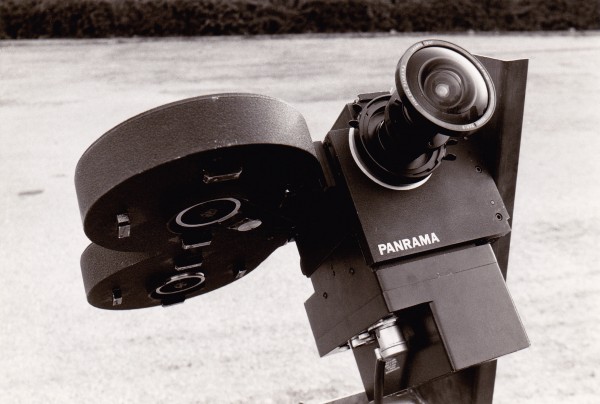
A 35mm Mitchell CNC camera converted for 8-perforation horizontal filming, fitted with the PANRAMA REOSC f/4 11.73 mm fisheye lens with a 160-degree field of view. Note that the camera is mounted on its side for the horizontal shooting, and tilted upwards to achieve the correct position of the horizon, when projected onto the domed screen.
Courtesy of Frédéric Jaulmes.
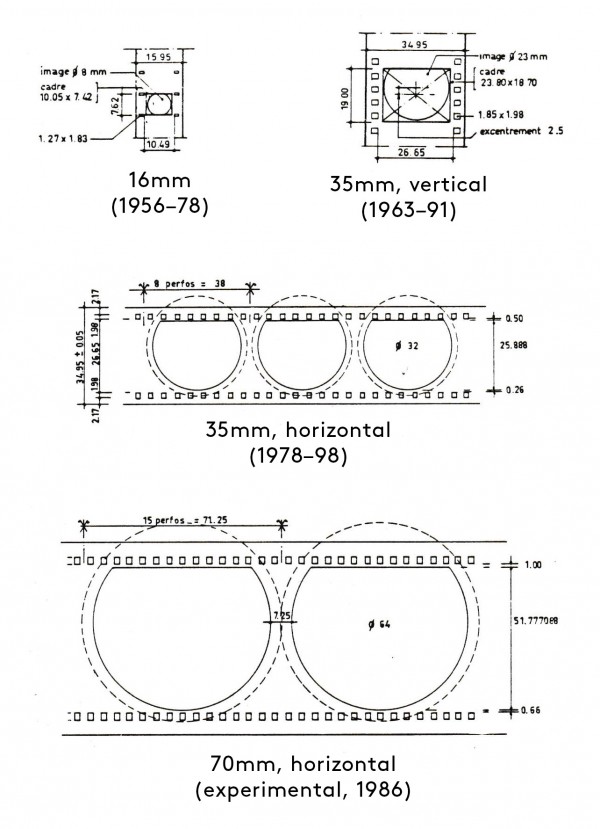
The PANRAMA format took multiple forms over the years, including: on 16mm, vertical advancement (top left); 4-perforation 35mm, vertical advancement (bottom left); 8-perforation 35mm, horizontal advancement (top right); and, in a one-off 1986 test in partnership with the Géode OMNIMAX theatre, Paris, 15-perforation 70mm, horizontal advancement (bottom right). The format always featured a wide-angle circular image on the film strip.
Jaulmes, Philippe (1981). L’écran total. Pour un cinéma sphérique. Paris: Lherminier, p. 84.
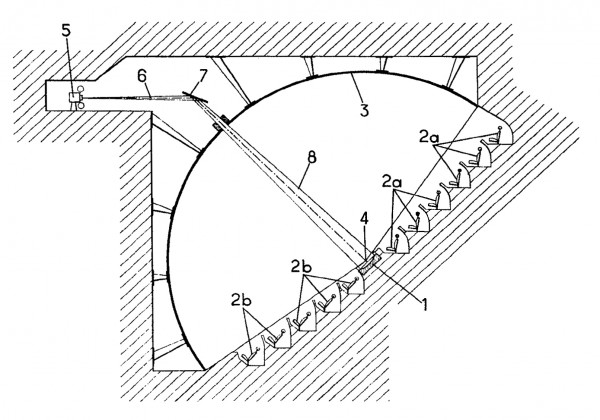
The 35mm projector was mounted above and behind the domed screen. Using mirrors, the projector beam was reflected into the auditorium and back onto the inclined screen.
Jaulmes, Philippe. Cinematographic projection room. French patent FR84774E, filed November 20, 1963, and issued April 16, 1965.
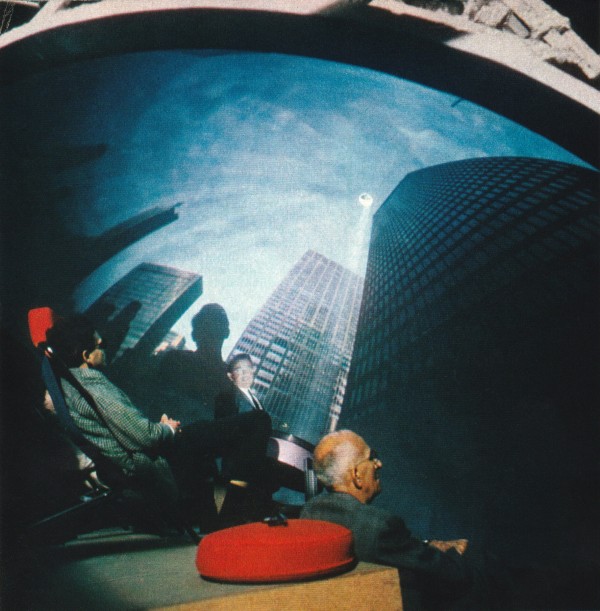
A PANRAMA screening at the “Ateliers du Cinéma total”, c. 1965. Philippe Jaulmes stands in front of the domed screen while footage of New York City is projected.
Dupont, Georges (1965). “Le cinéma hémisphérique”. Science et Vie, (Nov.): p. 84.

The Panrama theater in Clapiers, Hérault, c. 1978. The concave projection mirror can clearly be seen in the middle of the auditorium.
Courtesy of John Felton.
References
Jaulmes, Philippe (1963). Cinéma temps et espace; Introduction au Panrama. Montpellier: Causse & Castelnau.
Jaulmes, Philippe (1981). L’écran total. Pour un cinéma sphérique. Paris: Lherminier.
Jaulmes, Philippe (2010). Le cinéma hémisphérique. Naissance du cinéma grandeur nature. Montpellier: Éditions AVL Diffusion.
Jaulmes, Philippe (2014). “PANRAMA: When the Image Becomes Space“. Presentation at the conference 3D and Beyond, October 10, 2014, ZKM Karlsruhe, Germany.
Kießling, Maren (2023). “Fulldome Cinema – Untersuchungen zur Medienwirkung und Veränderung der Bilddramaturgie”. Dissertation, Martin-Luther-Universität, Halle-Wittenberg, Halle (Saale). Available at: http://dx.doi.org/10.25673/112601
Verny, Serge & Dominique Chateau (1993). “Les applications des procédés Panrama et Omnimax au cinéma d'animation”. Dissertation, Université Paris.
Patents
Jaulmes, Philippe. Salle de projection cinématographique. French patent FR1204643A, filed April 25, 1958, and issued January 27, 1960. https://patents.google.com/patent/FR1204643A
Jaulmes, Philippe. Salle de projection cinématographique. French patent FR73605E, filed May 14, 1958, and issued September 5, 1960. https://patents.google.com/patent/FR73605E
Jaulmes, Philippe. Cinematographic projection room. French patent FR84774E, filed November 20, 1963, and issued April 16, 1965. https://patents.google.com/patent/FR84774E
Jaulmes, Philippe. Viewing room for moving pictures. Canadian patent CA 748652, issued December 20, 1966. https://patents.google.com/patent/CA748652A/
Jaulmes, Philippe. Cinema room. German patent DE 1434669A1, filed November 18, 1964, and issued April 10, 1969. https://patents.google.com/patent/DE1434669A1
Jaulmes, Philippe. System for projecting and viewing pictures taken with a fish-eye camera. US patent US3539249, filed June 23, 1967, and issued November 10, 1970. https://patents.google.com/patent/US3539249A
Jaulmes, Philippe. Cinematographic projection room. French patent FR2052230A6, filed July 30, 1969, and issued April 9, 1971. https://patents.google.com/patent/FR2052230A6
Jaulmes, Philippe. Recording and projection process for projecting images on a spherical dome projection surface as well as a film on the implementation of the procedure. German patent DE 2841117A1, filed September 21, 1978, and issued March 29, 1979. https://patents.google.com/patent/DE2841117A1
Jaulmes, Philippe. Film projection and projection system. British patent GB2004660, filed September 20, 1978, and issued April 4, 1979. https://patents.google.com/patent/GB2004660A
Jaulmes, Philippe. Wide angle film shooting and projection of truncated images. US patent US4464029, filed May 12, 1982, issued August 7, 1984. https://patents.google.com/patent/US4464029A
Compare
Related entries
Authors
Dr. Maren Kiessling is an author, scientist and filmmaker, and is a lecturer in film at the Martin-Luther-University, Halle (Saale), Germany. As a filmmaker she has worked as camera operator, director, producer and editor. She has also worked for the international art film festival Werkleitz (2013–15) and has organized the international short-film festival Monstrale (2013–17). Her areas of academic research include full-dome cinema and the dramaturgy of the image. www.marenkiessling.de
Hubert Corbin is an author of crime novels and has worked in the cinema industry. From 1971, together with its inventor, the architect Philippe Jaulmes, he supported the development of the Panrama hemispherical screen projection system. He is currently secretary of the association Les amis du Panrama. He organized the Montpellier International Abstract Film Festival (1972–80), and worked for the Montpellier International Mediterranean Cinema Festival (1984–2013).
John Felton, graduated in art and communication, photography, cinema, from the College of Antioch, Ohio. He worked from 1978 with Philippe Jaulmes for the Ateliers du cinéma total and the Panrama, while continuing his work in photography and contemporary art (Regional Fund for Contemporary Art, exhibitions in Germany, Paris, Arles, Montpellier, etc.). He was treasurer of the association Les Amis du Panrama. He sadly died in 2024.
Frédéric Jaulmes, a graduate of ESRA (École supérieure de réalisation audiovisuelle), Paris, is a photographer and camera operator. He is the designer of the Pantocam (mechanical crane with remote fluid head). He participated in the development of the Panrama and created a 4m diameter transportable screen dome (weighing less than 35kg), equipped for 4K digital Panrama projection. He is president of the association Les Amis du Panrama.
Kiessling, Maren , Hubert Corbin , John Felton & Frédéric Jaulmes (2025). “PANRAMA”. In James Layton (ed.), Film Atlas. www.filmatlas.com. Brussels: International Federation of Film Archives / Rochester, NY: George Eastman Museum.


